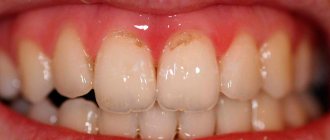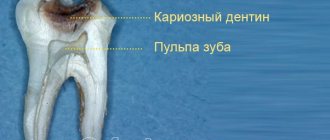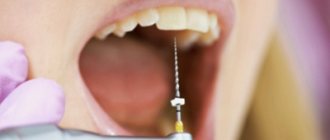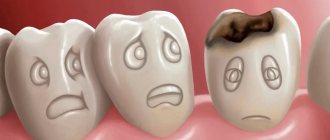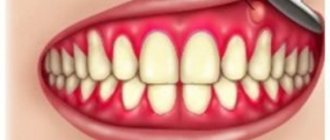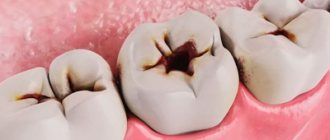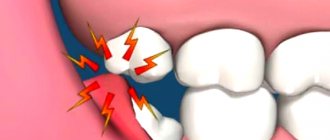According to statistics, caries occurs more often in children than in adults. This is one of the most common reasons for visiting a dentist, because not only permanent teeth, but also baby teeth are susceptible to destruction.
Children do not like to be treated, and often parents feel sorry for the child until the last moment and do not take him to the dentist in order to avoid stressful situations. But you need to understand that the health of his teeth in adulthood will depend on how they care for their baby’s oral cavity in childhood.
Why does caries occur in childhood?
It is known that caries is a pathological process that occurs in the hard tissues of teeth under the influence of internal and external factors. Carious lesions arise as a result of the “work” of cariogenic bacteria living in the oral cavity.
In this article
- Why does caries occur in childhood?
- Features of caries of milk teeth
- Symptoms of carious lesions in baby teeth
- Why is caries treated for young children?
- How is caries treated in children?
- Methods for treating childhood caries without drilling
- Invasive treatment of caries
- Do they give anesthesia to children?
- Prevention of childhood caries of primary teeth
By processing carbohydrates that enter the mouth with food, these bacteria produce acid. It is this that contributes to the destruction of enamel, dentin and other tooth tissues. Several factors contribute to the proliferation and active activity of cariogenic bacteria, which ultimately leads to the development of caries in children.
- Improper dental hygiene.
Insufficient cleaning from plaque, infrequent cleaning.
- Eating high in carbohydrates.
Children who eat a lot of sweets and flour, drink sweet compotes at night, and snack on chocolates are more susceptible to developing caries. A favorable breeding ground for microbes is formed in their mouth.
- Reduced immunity.
Weakened immune defense does not allow the body to effectively resist negative influences, so children with weak immunity develop caries more often.
- Features of intrauterine development.
The formation of teeth occurs in the first trimester of pregnancy, and it can be affected by the lifestyle, health, and previous diseases of the expectant mother.
These factors contribute to the fact that tooth enamel begins to lose mineral substances, cariogenic microbes multiply in the mouth, and as a result, dental caries develops.
Causes of caries
Caries occurs “thanks” to microorganisms living in the thickness of dental plaque. These bacteria - primarily streptococci, lactobacilli and actinomycetes - process food debris that remains on the teeth and produce acids that corrode the tooth enamel, leaching calcium from it. The tooth enamel begins to deteriorate.
The activity of bacteria varies from person to person: it is higher if a person brushes their teeth irregularly or not thoroughly enough, since soft interdental plaque is an excellent nutrient medium for them.
Features of caries of milk teeth
Saliva at an early age does not have sufficient antiseptic properties, and microbes easily multiply in the oral cavity. At the same time, the degree of enamel mineralization in baby teeth is less than in permanent teeth. In this regard, childhood caries spreads very quickly. If in an adult a carious lesion on permanent teeth can develop from an early stage to a deep one over several years, then in children the same process takes only a few months.
In a child, dental caries often affects several teeth at once. Only children have such types of caries as ring-shaped and planar. The condition of the dental system is also affected by various infectious diseases to which children are susceptible.
What is bottle caries?
The disease is a violation of the integrity of the outer layer of primary teeth or dentin (stronger tissue). The pathology quickly grows, spreading to healthy teeth. Even crowns that are barely visible on the surface are exposed to it.
Carious lesions are localized mainly on the front incisors and canines. Destruction begins in the cervical region, and then touches the entire coronal part in areas of contact with the gums.
The age category of the patients is indicated by the very name of the disease. The risk group consists of children 1-3 years old who are fed entirely or partially from a bottle.
Symptoms of carious lesions in baby teeth
The manifestations of caries depend on what stage the process is at.
For early caries (the so-called stain stage), a characteristic sign is a light spot or thin line on the surface of the tooth enamel. This is an area of demineralization - the focus of carious lesions. At this stage, it is difficult to notice caries without the help of a dentist, because the child does not show anxiety or complain of pain or discomfort.
When the process enters the superficial stage, a dark pigmented spot forms on the tooth enamel, which has a rough structure. The tooth may react to sweets, and during the examination the doctor discovers areas of softening of the enamel.
At the next stage of middle caries, dentin is damaged - the bone tissue of the tooth, in which a cavity is formed. The lesion looks like a darkened area, food gets stuck in the hole, and the child complains of pain when eating cold or hot food.
At the stage of deep caries, it is painful for the child to chew, the tooth reacts to any irritants, it can hurt on its own, and partial or complete destruction of the crown occurs. A characteristic type of childhood caries is the bottle form. It affects the dental neck and occurs in infants who often feed from a bottle for a long time. Depending on the form, stage of the disease, and the age of the child, the dentist will decide how to treat teeth affected by caries.
Clinical picture of caries
The first stage of the carious process
Caries occurs in the spot stage and in the superficial layers of enamel. Then we observe a stain on the surface of the tooth, which gradually becomes more dull, rough and porous.
The second stage of the carious process
If the enamel is chipped and a defect is formed, the tooth becomes more sensitive to irritants. Transient pain appears after eating cold, sweet and sour foods.
The third stage of the carious process
A carious cavity in dentin (tooth tissue located under the enamel). In this case, toothache appears depending on the situation, for example, when chewing on a diseased tooth or when there is a sudden change in the temperature of food, air, or when food gets into the cavity of a damaged tooth.
The fourth stage of the carious process
With further destruction, a deep carious cavity appears in the tooth, which gradually increases in size, so that eventually the tooth is destroyed and the pain appears spontaneous and constant. At this stage, an urgent visit to the dentist is necessary, as this indicates damage to the nerve of the tooth. In this case, it is not always possible to save the tooth.
Meet our tooth fairies and find out prices
Why is caries treated for young children?
There is a myth that baby teeth with caries do not need to be treated, as they will fall out anyway. In fact, dentists unanimously say that treatment of childhood caries at any age, both on milk and permanent teeth, is mandatory.
There are several reasons why caries of baby teeth should be treated before the age of 5-6:
- The baby tooth preserves space for the permanent tooth and stimulates its growth.
- It takes part in the chewing function and, therefore, in the digestion process.
- Baby teeth affected by caries are a source of chronic infection in the child’s body. In addition, the root of the baby tooth is located next to the germ of the permanent tooth. If caries in children is not treated, the inflammatory process can affect permanent teeth even before they erupt.
- Healthy baby teeth are necessary for a child to develop high-quality speech skills and correct pronunciation of sounds.
- If parents do not treat their child's caries, this can lead to untimely loss of baby teeth. Because of this, other teeth in the row shift, permanent teeth begin to cut in the wrong place, which leads to malocclusion.
- Early loss of a baby tooth can delay the eruption of a permanent one.
This is why it is so important to preserve baby teeth until they fall out naturally. And this can only be done if baby teeth are treated properly in a timely manner.
Prices
| Baby teeth | Price |
| Treatment of milk caries with placement of a filling made of glass ionomer cement | 2 350 ₽ |
| Treatment of caries with light polymerization fillings | 3 500 ₽ |
| Treatment of initial and superficial caries with Icon | 3 500 ₽ |
| Baby teeth | Price |
| Treatment of caries with filling made of glass ionomer cement | 2 350 ₽ |
| Treatment of caries with light polymerization fillings | 3 500 ₽ |
| Treatment of initial and superficial caries with Icon | 3 500 ₽ |
| Permanent teeth | Price |
| Temporary filling | 300 ₽ |
| Medical pad | 550 ₽ |
| Treatment of caries with placement of a light polymerization filling (anesthesia, cavity formation, antiseptic treatment, filling) | 2500 – 4 500₽ |
| Tooth restoration | 5 500 ₽ |
| Permanent teeth | Price |
| Temporary filling | 300 ₽ |
| Medical pad | 550 ₽ |
| Treatment of caries with placement of a light polymerization filling (anesthesia, cavity formation, antiseptic treatment, filling) | 2500 – 4 500 ₽ |
| Tooth restoration | 5 500 ₽ |
You can make an appointment with a pediatric therapist by multi-line phone or online on the website.
In our center, pediatric dentistry operates in the following clinics:
- Bratislavskaya, VDNKh, Verkhniye Likhobory, Krasnogorsk, Oktyabrskoye Pole, Petrovsko-Razumovskaya, Skhodnenskaya
How is caries treated in children?
What to do if a child has caries? Parents often ask dentists this question. And the answer is to treat. It is not so important when a child develops caries, whether he is one year old, 5 years old or 12 years old; dental disease is treated at any age. The only difference is how exactly dental caries are treated.
Different treatment methods are divided into two main groups - conservative and surgical. Conservative ones allow you to quickly and painlessly stop the carious process without drilling the tooth. Such techniques are most suitable for children, but they are effective only in the early stages of caries.
Surgical treatment involves drilling the carious cavity with a drill, removing the affected tissue and installing a filling. In case of deep or moderate caries, it will not be possible to cure a tooth without preparation.
Stages of development and manifestation of each form
The disease develops in 4 successive stages. Over time, teeth become more and more affected; in advanced cases, the baby may remain toothless.
Initial
Occurs in children aged 1-1.5 years. Small whitish spots are visible on the enamel. These are areas of tissue demineralization. In places of contact with the gums, whitish stripes are observed. It is not painful for the child; it is almost impossible to notice the lesion with the naked eye. It is for this reason that it is necessary to undergo preventive examinations with a dentist to detect the problem in a timely manner.
Experienced dental doctors will help determine the onset of the pathological process and take rehabilitation measures to prevent its further development.
Superficial
The enamel is partially destroyed, dentin is exposed. More often the problem is typical for children aged 2 years.
Such caries is noticeable, it looks like brownish spots. Sometimes the baby feels pain, but it occurs rarely and goes away quickly. At this stage, filling and preparation are indicated.
Average
Both layers are destroyed: dentin and enamel. If a small patient drinks or eats hot, cold, sweet, sour, acute pain appears. With subsequent rinsing and cleaning, the unpleasant sensations dull. Children become whiny and irritable.
Deep
At 2.5-4 years old, you can encounter serious damage to the teeth. The enamel is completely destroyed, the integrity of the dentin is significantly damaged. Soreness becomes a constant companion of the child, he refuses food and drink, cries. If the incisors and canines can be saved, crowns are installed. After removal, prosthetics are indicated.
Methods for treating childhood caries without drilling
A child has been diagnosed with a carious spot, that is, initial caries - what to do in such a situation. The doctor may offer several options.
- Fluoridation.
A special composition with a high concentration of fluoride is applied to the surface of the tooth enamel. The mineral substance helps strengthen the enamel, restore its structure, and helps stop the further process of tissue destruction.
- Remineralizing therapy.
The teeth are coated with compounds containing phosphorus, calcium, magnesium and other minerals. The treatment promotes the remineralization of enamel, restoring its strength and structural characteristics.
- Ozone therapy.
Another modern non-invasive method in which children's teeth are treated with ozone. It destroys different types of cariogenic bacteria, preventing their proliferation in the oral cavity.
- Silvering.
Previously, this method was very popular, today it is used less frequently due to the fact that it affects the aesthetics of the teeth. After silvering, white baby teeth acquire a distinct dark color. The essence of the method is that tooth enamel is coated with compounds containing silver. They have an antiseptic and bactericidal effect, forming a protective film on the surface that prevents the spread of infection. Silvering does not cure caries, but it helps slow down the process of tooth decay.
Possible complications
Without treatment, the child may be left without teeth. The enamel becomes very sensitive, any drinks and food cause pain. The risk of developing pulpitis increases.
If the rudiments of molars, canines and molars are affected, problems with bite, speech apparatus, and facial deformities arise. A complicated course requires the use of serious techniques and the involvement of specialized specialists in other fields (orthodontics, maxillofacial surgery, neurology, otolaryngology, etc.). Treatment may take many years and may not give the desired result.
Bottle caries is quite common in children under 3-4 years of age. The pathological process goes through several successive stages, each of which is characterized by its own symptoms and external manifestations. Depending on the stage of the disease, gentle or radical treatment methods are used. It is better not to bring the disease to such a state where depulpation and extraction are required. Otherwise, serious complications are possible that negatively affect the appearance, psychological state and quality of life of the child.
Invasive treatment of caries
If there is a hole in a tooth, it is treated as if it were permanent, using an invasive method. First, using a drill, the dentist prepares the carious cavity and removes softened, pigmented tissue. Rinses, dries and disinfects the tooth.
After sanitation, a filling is placed inside the cleaned cavity. Today, light-curing filling composites are the most popular. They are applied in layers, and at each stage they are illuminated with a special lamp for curing. Light-curing fillings have good strength, long service life and do not shrink, which reduces the risk of developing recurrent caries under the filling.
After installing the filling, the doctor adjusts it to the bite, grinds and polishes it, giving it the correct anatomical contours.
Symptoms of the disease
Clinical manifestations are directly dependent on the neglect of the pathological process. At first, the upper incisors and canines suffer, since they are actively involved in sucking the breast or bottle and come into contact with milk.
The disease begins with damage to the area where the coronal part adjoins the gums, which are least protected from negative effects. Then the entire crown is damaged.
At the very beginning, barely noticeable whitish spots appear on the teeth. Then they darken, and the baby experiences discomfort when eating. In the later stages of development of the pathology, the teeth are destroyed to the ground, and acute pain is noted.
Do they give anesthesia to children?
Many parents are concerned about how to painlessly treat teeth in children under 5 years old.
Non-invasive methods are absolutely painless. If a cavity needs to be prepared, anesthesia may be required. Children most often undergo two-stage anesthesia. First, the gum area is treated with an anesthetic gel, which numbs the injection site, and then an anesthetic injection is given.
In some cases, it is advisable to use sedation - when the child is introduced into a relaxed state of half-asleep using a special gas. Choosing the optimal method of pain relief and treatment is the responsibility of the dentist.
Special offer
Participate in the promotion
Promotion “1+1”: child and parent
You have entrusted NovaDent with the treatment of your child’s teeth, as a token of gratitude we are giving you a free consultation with any specialist (surgeon, implantologist, therapist, orthodontist, hygienist), as well as an orthopantomogram (panoramic photograph of the teeth) sent by email.
Take time for your health and take advantage of this great offer! 6 days until the end of the promotion May 31, 2021
Participate in the promotion
Expert of the article you are reading: Lapshina Maria Aleksandrovna Dentist, pediatrician
20 years
Clinical experience
Krasnogorsk
Moscow region, Krasnogorsk, Podmoskovny Boulevard, 5
+7
Free consultation with this specialist
Prevention of childhood caries of primary teeth
Caries of primary teeth can be prevented if you listen to the recommendations of dentists and follow preventive measures for this dental disease.
- Take care of your oral cavity from the moment the first tooth appears.
Previously, it was believed that young children needed to brush their teeth from about one year old, when they grew eight front incisors. Modern dentistry has revised this approach, and today it is recommended to brush children’s teeth as soon as the first baby tooth has erupted. This usually occurs between 6-9 months of age. It is clear that a baby cannot take care of the oral cavity on his own, so this task falls on the shoulders of the parents. The first teeth are cleaned with special fingertips or a baby brush without toothpaste. The brush should have a small cleaning head and ultra-soft bristles. As they approach the age of one year, they begin to brush their teeth with fluoride-free toothpaste. As the child gets older, the size of the head and the stiffness of the bristles may change. For example, for a child aged 5 years, you can purchase a toothbrush with medium-hard bristles.
- Follow the rules for brushing your teeth.
A child may develop caries even with regular brushing if this process is left to chance. Children under about 7 years old cannot brush their teeth properly, so parents should help them and monitor the process. Proper oral care involves brushing your teeth twice - in the morning after breakfast and in the evening before bed. The hygiene procedure should not take less than 2-3 minutes. It is important to ensure that the child thoroughly cleans each tooth on both sides and cleans the chewing surfaces. A large number of bacteria accumulate on the tongue and the inside of the cheeks, so at the end of cleaning you need to teach your child to remove plaque from these surfaces.
- Routine visit to the dentist.
Few children like to treat tooth decay. Modern methods make it possible to do this quickly, painlessly and without drilling, but only if the disease is detected at an early stage. This is why it is so important to take your child to the dentist twice a year, even if the child has no complaints. The doctor will check the condition of your teeth and give recommendations for care. Regular visits accustom your child to visiting the dentist and help get rid of fear. In the future, such children sit in the dental chair without any problems and have their teeth treated.
Follow these preventive measures and you may not have to treat your child’s caries.
Experts' opinion
The complex composition of ASEPTA Baby toothpaste allows you to simultaneously care for your gums and teeth. The product has:
- Certificate of state registration;
- Certificate of conformity No. ROSS RU. AG81.H01070.
The paste does not contain fluoride and does not require consultation with a doctor before use. The product is safe if swallowed, as it does not contain components harmful to the health of the baby.
Sources:
- Report on determining/confirming the preventive properties of toothpaste “ASEPTA PLUS” GENTLE WHITENING” Author: doctor-researcher A.A. Leontyev, head Department of Preventive Dentistry, Doctor of Medical Sciences, Professor S.B. Ulitovsky First St. Petersburg State Medical University named after. acad. I.P. Pavlova, Department of Preventive Dentistry
- Report on the determination/confirmation of the preventive properties of personal oral hygiene products “ASEPTA PLUS” Remineralization doctor-researcher A.A. Leontyev, head Department of Preventive Dentistry, Doctor of Medical Sciences, Professor S.B. Ulitovsky First St. Petersburg State Medical University named after. acad. I.P. Pavlova, Department of Preventive Dentistry
- Clinical experience in using the Asepta series of products Fuchs Elena Ivanovna Assistant of the Department of Therapeutic and Pediatric Dentistry State Budgetary Educational Institution of Higher Professional Education Ryazan State Medical University named after Academician I.P. Pavlova of the Ministry of Health and Social Development of the Russian Federation (GBOU VPO RyazSMU Ministry of Health and Social Development of Russia)
How to brush your teeth correctly?
It happens that trying to brush your teeth can sometimes cause a negative reaction. But you don't need to get upset about it. Better be patient and play. Remember that a child under three years of age, and older children too, learn about the world through play. Therefore, do not insist on brushing your teeth; it is unlikely that the baby will understand that this is important. Just play. For such games, a battery-powered brush and a toy on the handle are perfect. The movements performed by the brush for different groups of teeth should differ from each other. Cleaning the front teeth should be done from the gums with unidirectional vertical movements. Move the brush behind the cheeks in a circular manner, while the teeth should be closed. Cleaning the chewing surface of the teeth is carried out with horizontal movements from the inside (from the palate and tongue), back and forth, sweeping upward like a “broom”. But not only the movements that are performed are important, but also how much time is devoted to it. There are two ways to check whether your teeth are being brushed adequately:
- – in terms of time (you need to spend about 7-10 minutes brushing all your teeth), for this you can use an hourglass or any other clock
- – by the number of movements (for each area occupied by the bristles of the brush, 5-6 movements are needed).


